
Mediterranean Garden Society

Mediterranean Garden Society
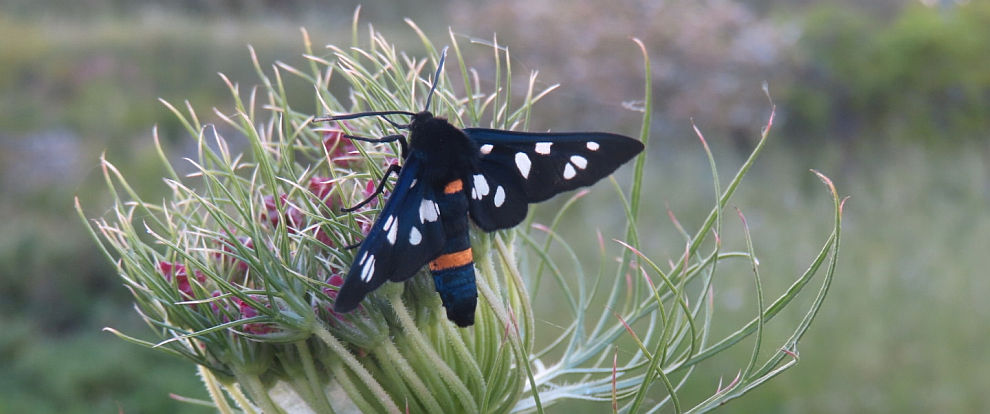
Maytime in Sicily
by Lesley Dellagana
Photographs by Lesley Dellagana
Photographs to illustrate the article published in The Mediterranean Garden No. 121, July 2025
The photo at the top of this page shows Daucus carota with Syntomis phegea moth (photo Lesley Dellagana)
Lesley Dellagana writes: The wild flowers in our Sicilian garden have never been more spectacular, probably as a result of the spring rains this year. The olive grove was awash with them: vibrant purple lucerne (Medicago sativa), the stately wild carrots (Daucus carota) and salsify (Tragopogon porrifolius) towering above the tall grasses. Vivid pink Valeriana rubra (syn. Centranthus ruber) and purple viper’s bugloss (Echium plantagineum) were interspersed with the delicate spires of Mediterranean linseed (Bellardia trixago) and smooth golden fleece (Urospermum dalechampii). In between, the elusive deep pink wild gladiolus (Gladiolus italicus), convolvulus of varying shades, shy nigella, bladder campion (Silene vulgaris), various varieties of calendula and the common corn poppy were peeping out from the tall grasses. It is sad that at the end of May/early June we must cut this superb spectacle to prevent the risk of fire, but we know that next spring it will once again return in all its splendour.
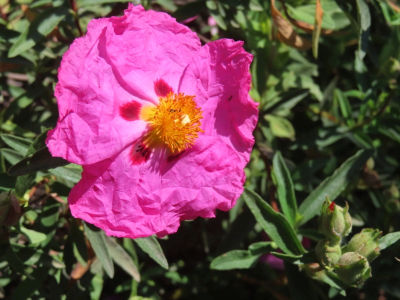
We have been struck by the climatic changes in our area. When we bought our house in the south-east of Sicily, close to Giarratana, eleven years ago, rainfall in May was rare; but in the past three years that has changed. We have seen a lot more rain during our May visits. In 2023 we had rain every day for the first two weeks of May, which was unprecedented. Even last year, when Sicily was experiencing a worrying drought across much of the island, there was a fair amount of rain during May. This year there has been regular rainfall throughout the spring months.
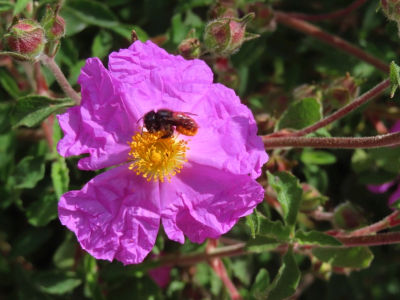
Arriving in Sicily towards the end of April this year, we were pleased to catch the last week or so of the early-flowering Rosa banksiae that we planted about five years ago and which has now completely covered a rather large pergola. It requires a lot of pruning every year after flowering, for otherwise it would take over the whole garden. Two other roses that were planted many years ago by the previous owner were the best we have ever seen them with their fine display of red and pink flowers; though our lovely Rosa glauca, with its small red flowers with yellow centre, was ready to burst into flower soon after we left. It had an amazing array of buds but unfortunately we shall miss its spectacular display this year. I have been surprised to see that roses can flourish in a harsh climate like this, although I am sure that the spring rains this year will have helped enormously.
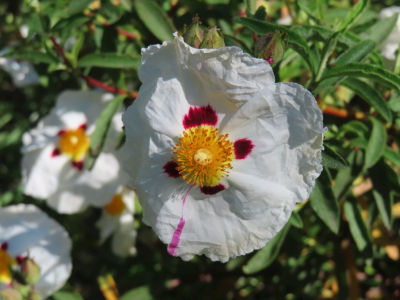
The wild irises as well as some of the cultivated varieties that we’d planted had finished flowering by late April. Fortunately, during the three weeks we were there, other yellow irises (Iris × hollandica) were coming into flower in the shadier parts of the garden. They were visited regularly by the bees that tunnel deep inside the pockets of the flowers to reach the pollen.
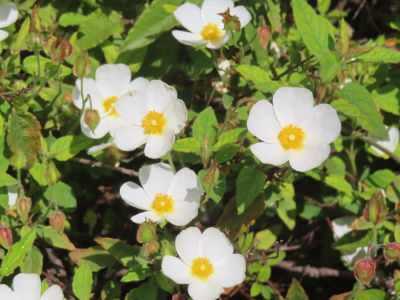
The bees adore the various cistuses that we started planting ten years ago and have continued to propagate: the deep pink Cistus × purpureus with its dark patches towards the yellow centre; the grey-leaved C. albidus with its pink flowers and yellow centre; the paler pink C. crispus; the spectacular C. ladanifer, white with its brown patches towards the yellow centre; and the pure white C. salviifolius with a pale yellow centre. All these appear to thrive in the unforgiving conditions of our Sicily garden and are at their most vibrant at this time of the year. I have been very surprised not to see more cistuses grown in our region. They need so little care and we never water them except during their first year of planting.
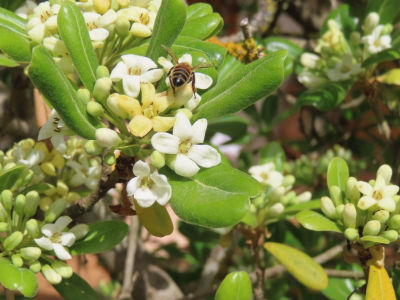
The bees are also very fond of our rather mature tree-sized Pittosporum tobira (Japanese mock orange) that fill the garden with their sweet fragrance in May and June. The Thymus vulgaris that we planted on the edge of our small section of gravel garden is also constantly abuzz with the sound of bees at this time of the year, as well as attracting wall brown butterflies (Lasiommata megera). We sit and watch and listen, absorbed and amazed.
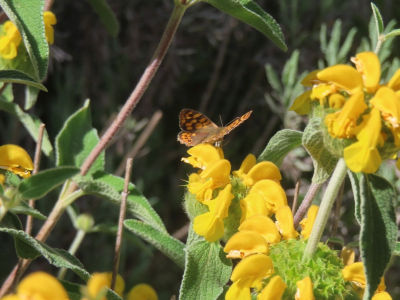
The butterflies also seem to love the Jerusalem sage(Phlomis fruticosa), one of my favourite plants that we introduced about eight years ago, with its unusual orbs of bright yellow flowers. Each year since then it has increased in height and now forms a bush that is also adored by hornets.
As we have learnt more about gardening in this challenging environment, we have tried to build on the beautiful display of wild flowers that appear every year with no help from us, introducing cultivated varieties, like the cistuses, jasmine, osteospermum, nepeta and Delosperma cooperi. In the past two years, we have begun to develop another area hitherto uncultivated, planting European fan palm (Chamaerops humilis), sago palm (Cycas revoluta), Pistacia lentiscus, Agave americana ‘Variegata’, French lavender, almond, apricot, and adding two more young pomegranate trees to the one already on the property that we inherited.
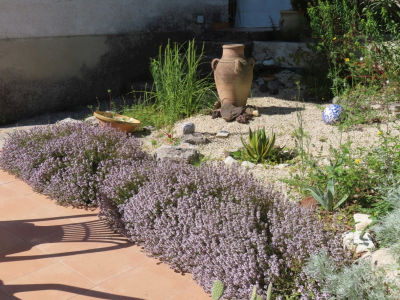
A small oak (Quercus pubescens) seeded itself a few years ago and seems to be growing happily beneath the very tall Aleppo pine (Pinus halepensis). We are unsure about whether we should try to move it. Will it continue to survive in the shadow of the pine tree and close to the lavender that we planted around seven years ago? I expect it will long outlive the lavender, but advice about whether we could successfully move it in this harsh climate would be most gratefully received.
When we first took on this garden just over eleven years ago, we were mere novices. We still are. It was, and remains, a daunting task, and we have had spectacular failures, as well as some successes, along the way. Some of our newly-found Sicilian friends, for understandable reasons, found it difficult to grasp our desire to grow flowers as well as food; over time, however, I have observed that they too are beginning to introduce a few more ornamental plants into their gardens and smallholdings, and occasionally now pass on to us the odd cutting from an ornamental plant. Taking on this garden has been demanding and extremely hard work. When we arrive at our house we despair, seeing all the weeds growing up through the gravel paths that we have laid on top of membrane; and seeing all the work that needs to be done to restore some order. By the time we are about to leave to return to the UK some order has indeed been restored – only for the cycle to begin again for our next time visit.
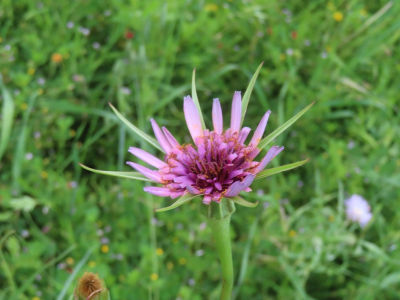
But there are so many rewards for the hard work: the spectacle of the wild flowers in the springtime; watching the plants that we have introduced establishing themselves an eventually flowering. And enjoying the visiting wildlife. During our last visit a family of coal tits (Periparus ater) had built a nest in the tiny space above the shutters at the back of the house. It was delightful to watch the parents coming and going from the nest with food for their nestlings.
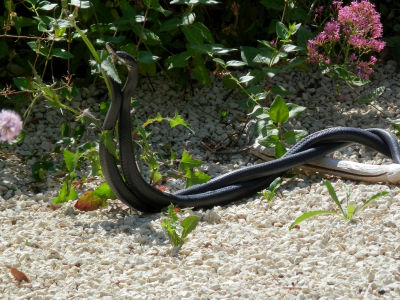
Lizards were scurrying about between the stones and low-growing vegetation. A family of buzzards could be seen on a clear day soaring above the woods at the back of the house. The stunning nine-spotted moths Amata phegea (formerly Syntonis phegea) were out in force, seeming particularly to enjoy settling on the wild carrot and scabious flowers. Damselflies and dragonflies darted about over the small pool. We even had the occasional visit from a handsome, rather brazen fox, which we later discovered was being fed by some builders working on a nearby house. A few years ago during our May visit we had our own private showing by two rather large snake-like creatures, which I believe may have been three-toed skinks (Chalcides chalcides); they performed a mesmerising courtship ritual just a few metres from where we were sitting, entwining themselves around each other, oblivious to us. We have not seen them since, but who knows what surprises may await us as we continue to grapple with our much-loved garden*.
*According to Greek mythology, the seer Tiresias saw snakes mating and as a result was turned into a woman. Later he saw snakes mating again and was turned back into a man. Since he was the only persn who had been both man and woman, the gods asked him which sex has the greater pleasure. His answer, ‘Women,’ for some reason made the goddess Hera so angry that she struck him blind. He appears as the blind seer in Sophocles’ play Oedipus Tyrannos, sometimes called Oedipus Rex (ed.).
THE MEDITERRANEAN GARDEN is the registered trademark of The Mediterranean Garden Society in the European Union, Australia, and the United States of America
website designed and maintained
by Hereford Web Design